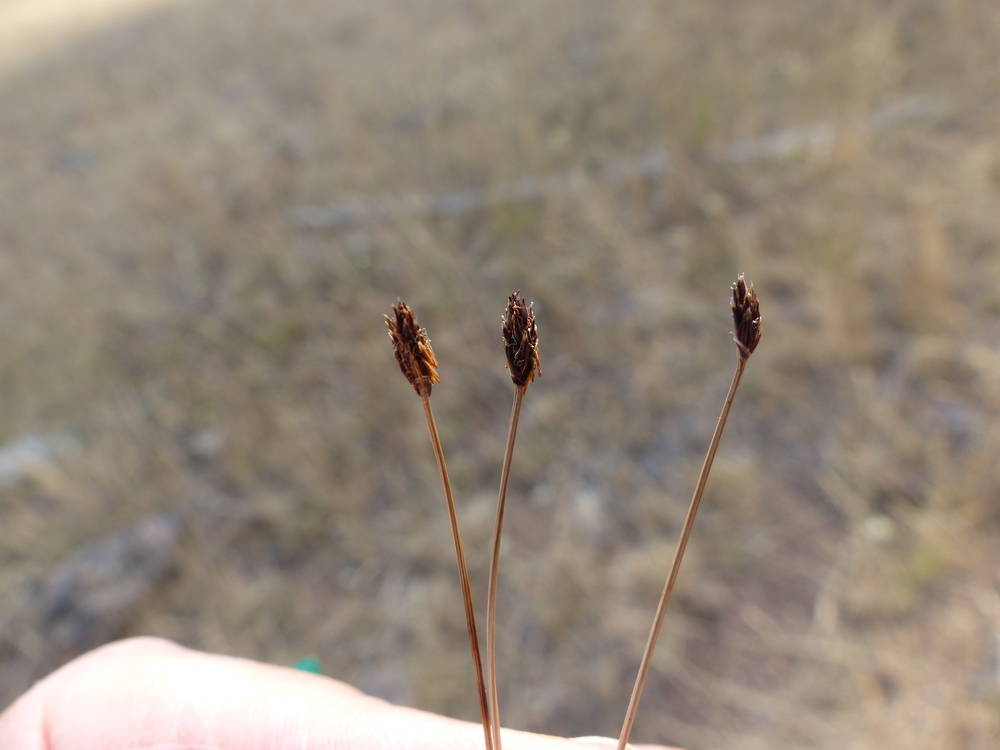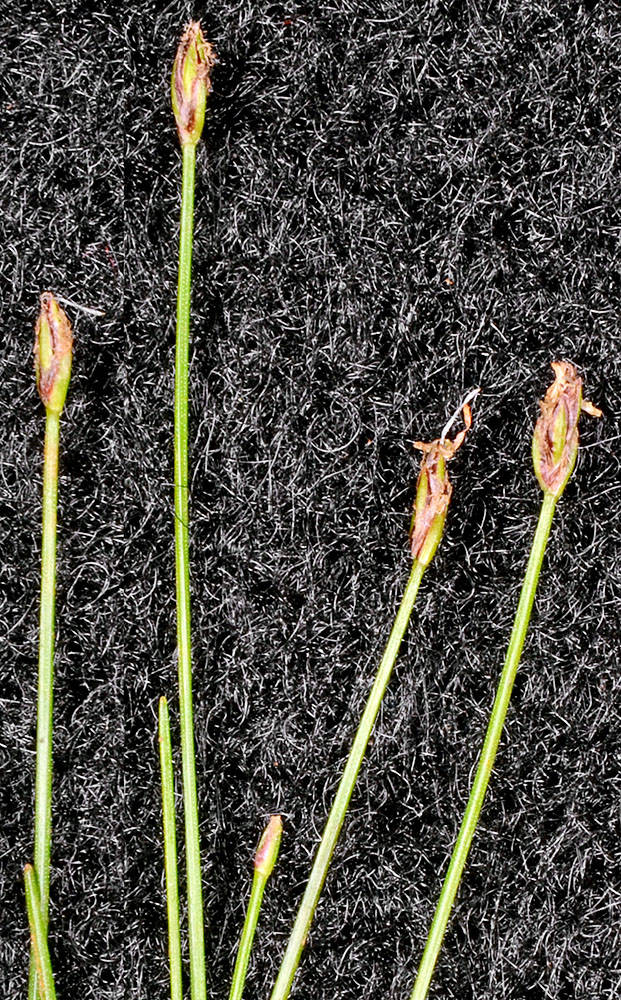Eleocharis bolanderi
Eleocharis
Bolander's spikerush
spikerush
subterete, 10–30 cm × 0.3–0.5 mm.
sometimes solitary; terete or 4-angled; smooth or ridged when dry.
basal, 2 per culm;
ligules absent;
blades absent or a mucro or awn (tooth) at apex of sheath.
terminal;
spike 1;
involucral bracts absent, rarely a proximal scale of spike resembling short bract.
ovoid, 3–8 × 2–3 mm;
proximal scale clasping; entire, subproximal scale with flower; floral scales 8–30, 4–5 per mm of rachilla, 2–3 × 1.5 mm;
apex entire; acute, often keeled in distal part of spike.
ovoid to cylindric;
scales 4–500 or more, spirally arranged; each subtending a flower or the proximal 1–2(3) empty.
perianth bristles 3–6, often unequal; from rudimentary to 50% of achene length;
anthers 0.9–1.4 mm;
stigmas 3.
bisexual;
perianth of (0)3–6(10) bristles; straight or curved; shorter than to 2 times longer than achene;
margins spinulose or smooth;
stamens 1–3; style, bases forming a tubercle that is usually persistent, usually enlarged, usually different in appearance from achene;
stigmas 2–3.
slightly to greatly compressed-trigonous, rarely thickly lenticular, 0.9–1.2 × 0.65–0.8 mm.
ellipsoid, obovoid, or obpyriform; biconvex; plano-convex, or trigonous to subterete.
persistent, not splitting;
apex obtuse, rarely hardened, lacking a tooth.
flat to shallowly pyramidal; lower than wide, 0.1–0.3 × 0.4–0.65 mm.
sharply distinct from or merging with the achene.
Eleocharis bolanderi
Eleocharis
Shallow, rocky, ephemeral streams. 1100–2100 m. BR, BW, Owy. CA, NV, ID; east to CO. Native.
Eleocharis bolanderi is easily recognized in summer when it forms masses of dry, brown, dormant and apparently dead culms in dry stream beds. It is easily pulled up to expose its cespitose habit. The virtually flat tubercles are particularly distinctive.
Cosmopolitan. Approximately 200 species; 16 species treated in Flora.
When collecting Eleocharis, get the underground parts and a lot of extra spikes! Identification usually requires ripping up spikes to view the rachilla and the flower, or lack thereof, just above the lower two floral scales. Most of these plants produce mature fruits in late summer or fall; they may not be identifiable if collected early in the season. For the purposes of this key, achene length is a measurement of the achene only, without the tubercle (persistent style base). Culms that are smooth when fresh may become ridged when dry. Culms of pressed specimens become flattened even if the culms were quadrangular in life, so determining the original shape requires rehydrating a section of culm. Culm widths are for culms pressed flat. Widths of floral scales are for flattened scales and can be determined by measuring the distance from midrib to one margin and doubling that. The proximal scale is the lowest in the spike; the subproximal scale is the second lowest. Reports of E. coloradoensis in Oregon remain unsubstantiated. If found, this species would key to either E. quinqueflora or E. suksdorfiana, however, unlike these species, the achenes of E. coloradoensis are less than 1.3 mm long.
Barbara Wilson, Richard Brainerd, Nick Otting
Barbara Wilson, Richard Brainerd, Nick Otting
- Local floras:
CA,
OR,
WA
- Local Web sites:
CalFlora,
CalPhotos,
Flora NW,
PNW Herbaria
WildflowerSearch
iNaturalist (observations)
USDA Plants Database
- LBJ Wildflower Center
- SEINet
- Plants of the World Online
- Encyclopedia of Life
- Wikipedia
- Google Image Search
- Local floras:
CA,
OR,
WA
- Local Web sites:
CalFlora,
CalPhotos,
Flora NW,
PNW Herbaria
WildflowerSearch
iNaturalist (observations)
USDA Plants Database
- LBJ Wildflower Center
- SEINet
- Plants of the World Online
- Encyclopedia of Life
- Wikipedia
- Google Image Search




